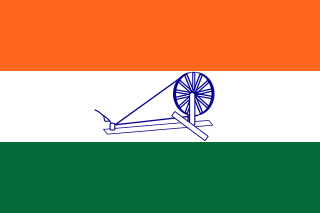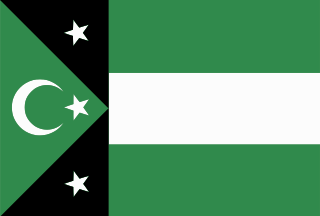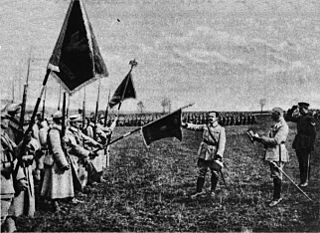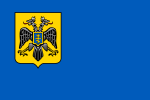
The Central Powers, also known as the Central Empires, were one of the two main coalitions that fought in World War I (1914–1918). It consisted of the German Empire, Austria-Hungary, the Ottoman Empire, and Bulgaria; this was also known as the Quadruple Alliance.

The history of Europe is traditionally divided into four time periods: prehistoric Europe, classical antiquity, the Middle Ages, and the modern era.

The Treaty of Brest-Litovsk was a separate peace treaty signed on 3 March 1918 between Soviet Russia and the Central Powers, by which Russia withdrew from World War I. The treaty, which followed months of negotiations after the armistice on the Eastern Front in December 1917, was signed at Brest-Litovsk.

The Axis powers, originally called the Rome–Berlin Axis and also Rome–Berlin–Tokyo Axis, was a military coalition that initiated World War II and fought against the Allies. Its principal members were Nazi Germany, the Kingdom of Italy and the Empire of Japan. The Axis were united in their far-right positions and general opposition to the Allies, but otherwise lacked comparable coordination and ideological cohesion.
A puppet state, puppet régime, puppet government or dummy government is a state that is de jure independent but de facto completely dependent upon an outside power and subject to its orders. Puppet states have nominal sovereignty, except that a foreign power effectively exercises control through economic or military support. By leaving a local government in existence the outside power evades all responsibility, while at the same time successfully paralysing the local government they tolerate.
In the field of international relations, a client state, is a state that is economically, politically, and militarily subordinated to a more powerful controlling state. Alternative terms for a client state are satellite state, associated state, and dominion, condominium, self-governing colony, and neo-colony, protectorate, vassal state, puppet state, and tributary state.

The Greater East Asia Co-Prosperity Sphere, also known as the GEACPS, was a pan-Asian union that the Japanese Empire tried to establish. Initially, it covered Japan, Manchukuo, and China, but as the Pacific War progressed, it also included territories in Southeast Asia. The term was first coined by Minister for Foreign Affairs Hachirō Arita on June 29, 1940.
A provisional government, also called an interim government, an emergency government, a transitional government or provisional leadership, is a temporary government formed to manage a period of transition, often following state collapse. Provisional governments are generally appointed, and frequently arise, either during or after civil or foreign wars, or during difficult times such as during invasion, economic crisis, or widespread infiltration of saboteurs and counter-revolutionaries such as during the French Revolution.

The Kingdom of Poland, also known informally as the Regency Kingdom of Poland, was a short-lived polity that was proclaimed during World War I by the German Empire and Austria-Hungary on 5 November 1916 on the territories of formerly Russian-ruled Congress Poland held by the Central Powers as the Government General of Warsaw and which became active on 14 January 1917. It was subsequently transformed between 7 October 1918 and 22 November 1918 into the independent Second Polish Republic, the customary ceremonial founding date of the latter being later set at 11 November 1918.

The Provisional Government of Free India or, more simply, Azad Hind, was a short-lived Japanese-supported provisional government in India. It was established in Japanese occupied Singapore during World War II in October 1943 and has been considered a puppet state of the Empire of Japan.

During the Polish–Soviet War of 1919–1921, Soviet Russia and its client state, Soviet Ukraine, were in combat with the re-established Second Polish Republic and the newly established Ukrainian People's Republic. Both sides aimed to secure territory in the often disputed areas of the Kresy, in the context of the fluidity of borders in Central and Eastern Europe in the aftermath of World War I and the breakdown of the Austrian, German, and Russian Empires. The first clashes between the two sides occurred in February 1919, but full-scale war did not break out until the following year. Especially at first, neither Soviet Russia, embroiled in the Russian Civil War, nor Poland, still in the early stages of state re-building, were in a position to formulate and pursue clear and consistent war aims.
A temporary capital or a provisional capital is a city or town chosen by a government as an interim base of operations due to some difficulty in retaining or establishing control of a different metropolitan area. The most common circumstances leading to this are either a civil war, where control of the capital is contested, or during an invasion, where the designated capital is taken or threatened.

The Provisional National Government of the Southwestern Caucasus, Provisional National Government of South West Caucasia or Kars Republic was a short-lived nominally-independent provisional government based in Kars, northeastern Turkey. Born in the wake of the Armistice of Mudros that ended World War I in the Middle East, it existed from December 1, 1918 until April 19, 1919, when it was abolished by British High Commissioner Admiral Somerset Arthur Gough-Calthorpe. Some historians consider it to have been a puppet state of the Ottoman Empire.

The Provisional Government of Western Thrace later Independent Government of Western Thrace, was a small, short-lived unrecognized republic established in Western Thrace from August 31 to October 25, 1913. It encompassed the area surrounded by the rivers Maritsa (Evros) in the east, Mesta (Nestos) in the west, the Rhodope Mountains in the north and the Aegean Sea in the south. Its total territory was approximately 8600 km2.

The Crimean People's Republic or Crimean Democratic Republic was a self-declared state that existed from December 1917 to January 1918 in the Crimean Peninsula. The Republic was one of many short-lived states that declared independence following the 1917 Russian Revolution caused the collapse of the Russian Empire. The Crimean People's Republic was the First Turkic and Muslim Democratic Republic in the World.

While Poland did not exist as an independent state during World War I, its geographical position between the fighting powers meant that much fighting and terrific human and material losses occurred on the Polish lands between 1914 and 1918.

The territorial conquests of the Empire of Japan in the Western Pacific Ocean and East Asia began in 1895 with its victory over Qing China in the First Sino-Japanese War. Subsequent victories over the Russian Empire and German Empire expanded Japanese rule to Taiwan, Korea, Micronesia, southern Sakhalin, several concessions in China, and the South Manchuria Railway. In 1931, Japan invaded Manchuria, resulting in the establishment of the puppet state of Manchukuo the following year; thereafter, Japan adopted a policy of founding and supporting puppet states in conquered regions. These conquered territories became the basis for the Greater East Asia Co-Prosperity Sphere in 1940.

The history of Japanese foreign relations deals with the international relations in terms of diplomacy, economics and political affairs from about 1850 to 2000. The kingdom was virtually isolated before the 1850s, with limited contacts through Dutch traders. The Meiji Restoration was a political revolution that installed a new leadership that was eager to borrow Western technology and organization. The government in Tokyo carefully monitored and controlled outside interactions. Japanese delegations to Europe brought back European standards which were widely imposed across the government and the economy. Trade flourished, as Japan rapidly industrialized.



























